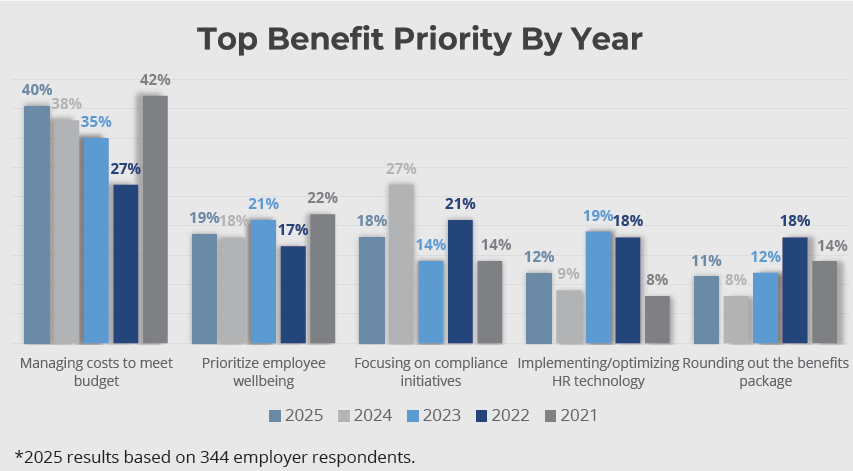As another year has kicked off, employers have many areas of focus regarding their benefit programs. It can also be challenging to achieve all goals in a single year, so decision-makers must prioritize their efforts based on their unique circumstances.
On February 20, we conducted a survey to gain insight into employers’ top priorities for 2025 and how they compare to prior years. We also sought to understand the strategy(ies) employers are deploying to manage their benefits costs. The results are in the charts below.

Benefit managers always have an eye on the program’s finances, and with inflation, rising pharmacy spending, and continued chronic conditions, this year will be a challenging one in the cost area. As such, it is no surprise that four in ten employers say managing costs to meet their expected budget is the #1 priority this year (the highest rate since 2021).
Strategies to Manage Benefit Costs to Meet Budget
- 29% Add a wellness program (Compared to 14% in 2024)
- 14% Offer direct primary care/concierge services (Compared to 2% in 2024)
- 11% Implement disease/care management program (Compared to 6% in 2024)
- 7% Exclude coverage for certain drugs (Compared to 6% in 2024)
- 6% Transfer stop-loss coverage to group captive (Compared to 3% in 2024)
- 3% Add Center of Excellence (Compared to 0% in 2024)
- 3% Provide second opinion program (Compared to 0% in 2024)
- 41% Are taking no specific action (Compared to 60% in 2024)
Industry Insights
While employers are generally focused on managing costs, we did see variances in priorities by industry.
Construction employers cited compliance initiatives as their top priority for 2025 (29%), remaining consistent with 2024. They are also the least likely to implement cost-saving strategies, with only 32% taking some type of action.
Thirty-nine percent of non-profits stated their main priority was employee well-being, a change from last year when a focus on compliance initiatives was their lead priority.
Key Findings
The January 2025 renewal cycle was difficult, with 39% of employers seeing their medical costs increase by 7% or more after all changes were implemented. After absorbing significant premium increases, ensuring that costs do not exceed budget is even more critical. Plan sponsors cannot afford to sit idle. Almost 60% of employers are deploying strategies this year to help manage their costs – a 20% increase from last year. This effort is led by expanding opportunities for employees to improve their health, with twice as many employers investing in wellness programs as last year.
With a proactive approach, employers can work to impact their benefits spend. While nearly 40% have yet to implement specific strategies, those who do have the opportunity to improve financial stability, enhance employee well-being, and better navigate future renewal cycles. By making thoughtful adjustments, employers can balance affordability with the need to offer competitive benefits.
Should you have any questions regarding any of this information or want to review your priorities, contact your local INSURICA branch.
Copyright © 2025 Assurex Global. This is not intended to be exhaustive nor should any discussion or opinions be construed as legal advice. Readers should contact legal counsel or an insurance professional for appropriate advice.
About the Author
Share This Story
Related Blogs
Trump Administration Reshapes Health Plan Oversight
The Trump administration has issued a series of executive orders aimed at recalibrating federal oversight of employer-sponsored health plans. These directives target unpublished rules and agency enforcement priorities, signaling a shift toward deregulation and increased flexibility for plan sponsors.
Compliance Update: Gag Clause Attestations, Contraceptive Coverage Ruling, and SF Ordinance Impacts
As Q4 begins, benefits managers face a trio of compliance developments with implications for plan design, documentation, and year-end filings. Two are federal in scope, while one local ordinance continues to affect employers nationwide.
Benefits Administration Update: MLR Rebates, Texas SB 1332, and Year-End Priorities
As the final quarter of 2025 begins, several developments in benefits administration are reshaping how employers manage compliance, coverage, and communications. From rebate distribution rules to state-level legislation, benefits managers should take note of key updates that may affect plan operations and documentation heading into year-end.






